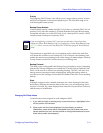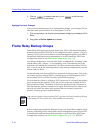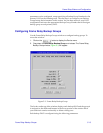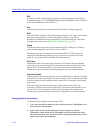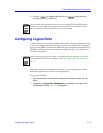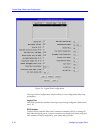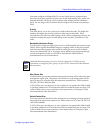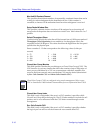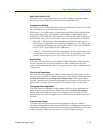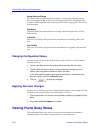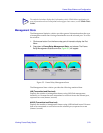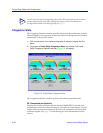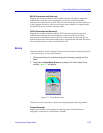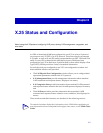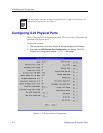
Configuring Logical Ports 5-19
Frame Relay Status and Configuration
Make Calls Outside CUG
This Þeld is only conÞgurable if the port is a CUG member; it speciÞes whether
the logical port can make calls to network users outside that CUG.
Encapsulation Method
This Þeld speciÞes whether the trafÞc will be encapsulated by Annex G or RS 1490
for transmission across the frame relay network.
With Annex G, an LAPB frame is encapsulated immediately following the frame
relay header (ßag, 2-byte T1.618 header, LAPB address, LAPB control, LAPB
I-Þeld, [x.25/x.75]). With RFC 1490, the order is: T1.618 header, Q.922 control byte,
Q.933 NLPID, 2-byte level-2 protocol ID, 2-byte level-3 protocol ID, LAPB frame.
¥ RFC 1490 Ñ The protocols will be identiÞed on the DLCI based on their
NLPIDs and (if applicable) level-2 and level-3 headers (e.g., X.25: ßag, T1.618
2-byte header, 0x03 Q.922 control, 0x08 Q.933 NLPID, T1.617 level-2 LAPB PID
0x51 81, T1.617 level-3 PID 0x67 80, LAPB frame).
¥ Annex G Ñ Each protocol must be encapsulated in X.25 for transmission over
a single DLCI, because Annex G allows the DLCI to be used only by X.25. Each
protocol would require its own X.25 virtual circuit and level-3 window.
Blocked Flag
This value will cause the port to be enabled (if No) or disabled (if Yes) when the
device is powered up or re-booted.Whichever state is selected, the port will
remain in that state until this value is changed or until an enable or disable action
is performed.
Flow Control Negotiation
This Þeld allows for negotiation of ßow control parameters (packet and window
sizes for data transmission in either direction) on a per-call basis. If No is selected,
the Default Packet Size and Setup Packet Window Size will be used. If Yes is
selected, a packet and/or window size included in a call packet will be used. (If a
packet and/or window size is not included, the default values will be used.)
Throughput Class Negotiation
This Þeld allows for negotiation of throughput classes for data transmission in
either direction on a per-call basis. If No is selected, the Default Throughput
Class will be used. If Yes is selected, any throughput class included in a call
packet will be used. (If a throughput class is not included, the default value will
be used.)
Prevent Local Charge
This Þeld is used to prevent calls from being charged to this port. If Yes is
selected, incoming calls from the network with Reverse Charging speciÞed will be
rejected and outgoing calls will have Reverse Charging inserted if it is not already
in the call packet. If No is selected, then calls can be charged to this port.



